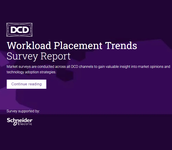Today’s cloud computing market is dominated by a number of global hyperscale providers offering a variety of infrastructure and platform services.
Eliminating the need to invest in or build out on-premises IT architectures, these providers have made it fast and easy for organizations to rapidly scale compute and IT resources to meet their workload and user demands.
With industry analyst Gartner predicting that worldwide public cloud spending is set to surge in 2024, the popularity of hyperscalers doesn’t look likely to decline anytime soon. Currently accounting for 66 percent of the public cloud market, the three largest hyperscale providers - AWS, Microsoft Azure and Google Cloud - are undertaking data center buildouts and upgrade programs to match anticipated market demand growth over the coming years.
However, while hyperscalers offer a plethora of benefits, not everything is appropriate or right for the public cloud. When defining a cloud strategy, organizations will need to evaluate their security and compliance needs carefully in order to understand how best to leverage the public cloud.
Getting to grips with hyperscale
Used in the right place, at the right time, hyperscalers represent a highly compelling proposition.
In addition to providing access to on-demand IT resources and cloud-hosted services on a pay-per-use basis, they offer a range of tools and services designed to help organizations manage key aspects of their cloud environment - everything from data storage and security to monitoring and reporting.
For organizations with limited in-house cloud expertise, this significantly reduces the challenge of managing and securing data in the cloud. This being said, organizations will need to consider their data security, privacy, and data sovereignty needs before migrating any workload to the public cloud. This is especially the case for organizations operating in the legal, finance, or healthcare sectors, where adherence to strict compliance and security requirements is a must-have.
The good news is that there are a variety of options available to organizations that want to move beyond traditional on-premises data centers and harness the transformative power of the cloud. These include private and hybrid cloud models that make it possible to move workloads to different environments in line with security and compliance needs.
The benefits of hybrid cloud
Ideal for organizations that need to initiate customized controls to meet regulatory requirements, hybrid cloud makes it possible to house data and workloads based on compliance, policy, or security requirements.
Enabling organizations to ‘mix and match’ private and multiple public cloud services, hybrid and multi-cloud models offer a best-of-both-worlds alternative that makes it possible to manage sensitive data and retain control over its access and storage location. Added to this, the geo-redundancy afforded by deploying a multi-cloud environment means that mission-critical components can be distributed across multiple data centers to mitigate downtime risks and optimize backup and recovery strategies.
Delivering a range of benefits, the adoption of a hybrid cloud approach ensures that each workload can be hosted in the most appropriate execution venue. For example, hyperscale public cloud can be used for at scale needs with less sensitive compliance requirements. Meanwhile, on-premises infrastructure or private clouds are used to handle workloads where security, resilience, or disaster recovery are top priorities. The good news is that some hyperscalers offer on-premises versions of their public cloud services.
Navigating the challenges
To optimize their cloud adoption strategies, and ensure they architect the best fits for their needs, organizations will first need to undertake detailed assessments of their workloads to determine which cloud combinations to go for.
Weighing up which cloud options are most appropriate for which workloads isn’t always an easy task. Ideally, organizations should utilize a cloud adoption framework to help scope out the overall security and business drivers that will influence their cloud strategy decision-making. Enabling organizations to identify and mitigate risks and ensure compliance as they move ahead, these frameworks make it easier to proceed confidently with their cloud adoption plans.
Since every infrastructure strategy will have unique requirements that include tailored security measures, leveraging the expertise of cloud security professionals will also prove invaluable for ensuring appropriate security measures are in place. Similarly, organizations will be able to gain a deeper understanding of how best to orchestrate their on-premises, private, and public clouds in a unified and cost/performance-optimized manner.
Moving ahead with confidence
By prioritizing security, compliance, and strategic adoption, organizations will be able to define a cloud strategy that makes it possible to leverage hyperscale services while appropriately safeguarding their data and operations.
Through a holistic approach that considers how best to protect their cloud-hosted applications and secure data in transit between different environments, organizations will be able to take advantage of the scalability, flexibility, and enhanced functionality offered by hyperscalers without introducing unnecessary risk.




